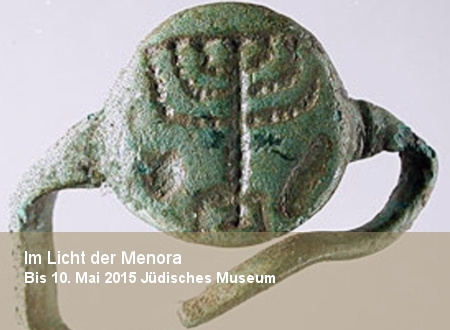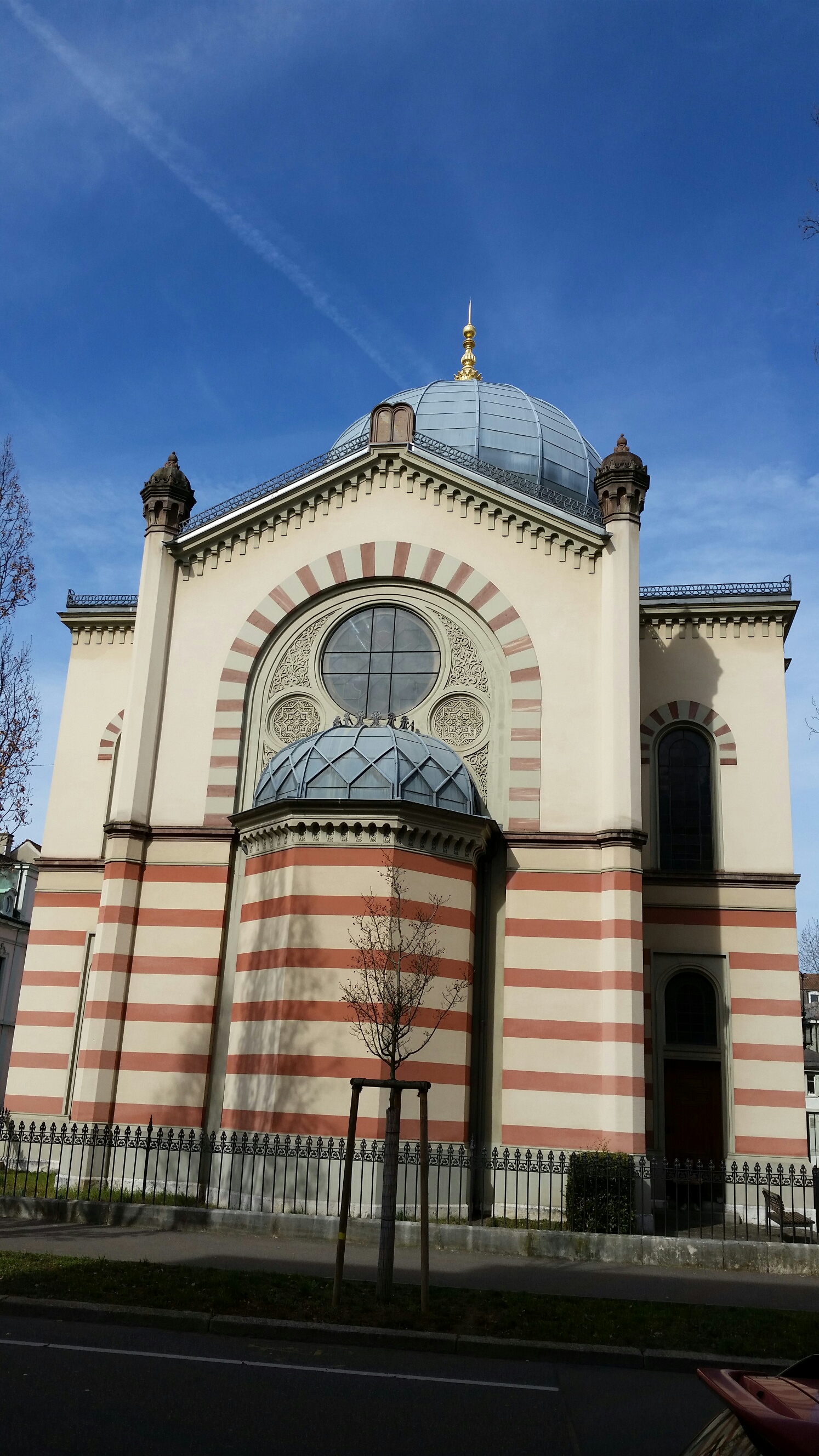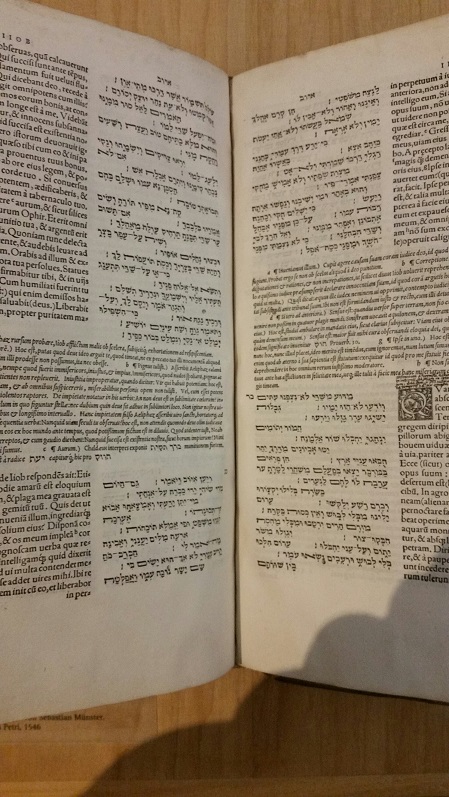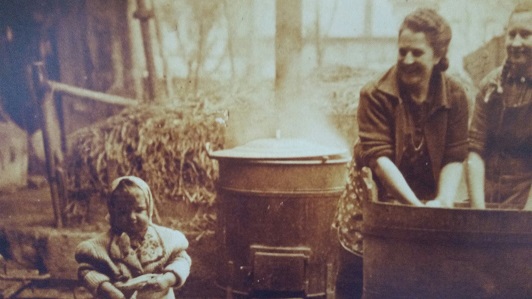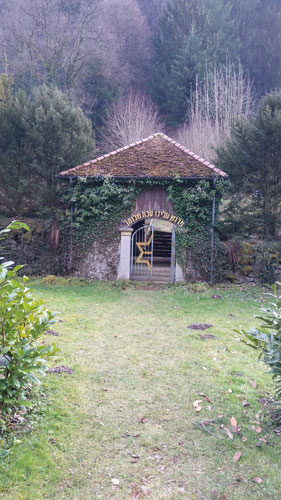Spring-Break Study-Research Trip in Judaic and German Studies
In March of 2015, Associate Professor of German Studies Rob Leventhal lead aSpring-Break Study-Research Trip in Judaic and German Studies. The traveloge follows:
Jewish Cultural and Social Pathways in the Upper Rhine Valley
We were slated to leave Thursday, March 5th, from RIC on a study-research spring-break trip, sponsored by the Meyers Stern Endowment in Judaic Studies that would take us to the Upper Rhine Valley from Basel, Switzerland to Cologne Germany in eight days. Time was of the essence. On Monday of that week, it became clear that winter snowstorm Thor was going to hit the mid-Atlantic hard. On the assumption that our flight from RIC to Dulles would be cancelled, and working together with Dean Lu Ann Homza and Covington Travel, we decided to drive to Dulles in the hope that our flight to Frankfurt would be able to depart. We were right! The RIC-Dulles flight was cancelled, and our Frankfurt flight, although delayed four hours by the blinding snow - it reached 10 inches at Dulles that afternoon and eve - was finally de-iced and took to the sky at 9:45pm.
Day 1: Frankfurt
Our first stop was Frankfurt am Main, a major center for Jewish life from the early modern period until the Nazi seizure of power in 1933. Our destination was the Frankfurt Jewish Museum, in particular the special exhibition “Im Lichte der Menora” (In the Light of the Menora), about the Jews in Roman settlements in the Upper Rhine Valley dating from the 4th century CE. Here, we were able to view, for example, the famous “menorah” ring from the 4th century CE found at the Augusta Raurica just outside of Basel. This exhibit gave the students and me the very real sense of Christians and Jews living together in communities throughout the Rhine Valley as the Empire began to dissolve. Decisive information about temples, worship, family, the Rabbis, gender, communality and governance (and self-governance!) helped us construct a vivid portrait of Jewish life in medium- sized and even smaller communities in the Rhine Valley from the 4th century CE until 1200.
|
The Menora Ring, Augusta Raurica, 4th century CE Days 2 and 3: Basel |
A bowl with the Star of David, 4-5th century CE
|
|||
|
The Central Synagogue Hebrew Bible Translation, Basel 1546 |
The next stop was Basel, Switzerland, where for centuries Jews were forced to live outside of the City gates and could only gain entrance on specific days with a special pass. We visited the Augusta Raurica, one of earliest and best-preserved Roman archeological sites north of Alps, where many Jewish artifacts from the period 4th – 5 th c. CE have been found. The Jewish Museum of Switzerland provided the perfect example of what is called the “back room” museum, very rich in materials but with literally no “storefront.” It is hidden in an inner courtyard in one of Basel’s upscale neighborhoods. Our guide took us into the Basel Synagogue, built in the second half of the 19th century, designed by a German (Christian) architect. Basel was one of the premier book-printing centers of Europe in the 1500s, and we saw beautiful examples of translations of the Hebrew Bible from the mid 16th century. Basel was also the home to the First World Zionist Congress in 1897, and Herzl’s presence could be felt by the large photograph of him at the bridge overlooking the Rhine. Two key Jewish communities outside of Basel, Lengau and Endingen, survived. Our guide was an Israeli who had married a man from one of these surrounding Jewish communities. |
|||
|
Jewish Life in Sulzburg in the Black Forest, circa 1920. Days 4 and 5: Freiburg / Sulzburg/ Staufen |
Jewish Swim Club, Sulzburg, circa 1920.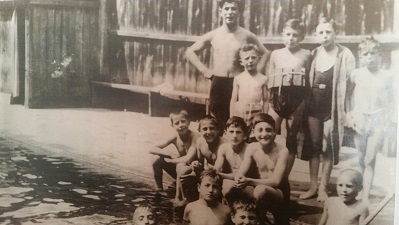 |
|||
|
On Sunday, we took the train to Freiburg-im-Breisgau, at the foot of the Black Forest in Southwestern Germany. Freiburg itself was the launching pad for our excursion to the tiny village of Sulzburg in the Black Forest, where a Jewish community thrived until it was deported to the French Concentration Camp Gurs, and from there to the killing centers in the East. In the beautiful Synagogue, plundered by the Nazis but not destroyed as it was too close to the surrounding homes, restored and now housing a small museum dedicated to the Jews of Sulzburg and their history, we saw evidence of how Jews lived in the late 18th, 19 th and early 20th centuries with Christians side by side as neighbors. A map showed us how the Jewish homes were spread throughout the small village; other images and objects revealed the life of Jews: merchants, tradesmen, traveling salesmen of kitchen and farm wares, Rabbis, schoolteachers, physicians. We saw evidence of a Jewish Swim Club from the 1920s, and the amazing cemetery just outside of the village itself on the side of a hill, still standing – not desecrated –covering the entire side of a hill. The tales of Jacob Picard (“The Marked One”) of Landjuden in the late 19th and early 20th century accompanied us as we made our way up the beautiful valley into the Black Forest to an Inn where we enjoyed cake and tea. In Freiburg, we met with Daniela Schaffart, the director of the wonderful documentary film Geschichte ganz nah — Eine Reise zu den Gedenkstätten in meiner Heimat (History Close-Up: A Journey to the Memorial Sites of my Homeland). |
The Jewish Cemetery of Sulzburg
|
|||

The “Team” in front of the New Synagogue, Mainz, from left to right: W&M students Sarah Wall, Casey Neary, Claire Etheridge, Natalie Morgan, Mary Andino, Chloe Wang, Matthew Noah baker
Days 6 and 7: Magenza: Mainz / Speyer / Worms
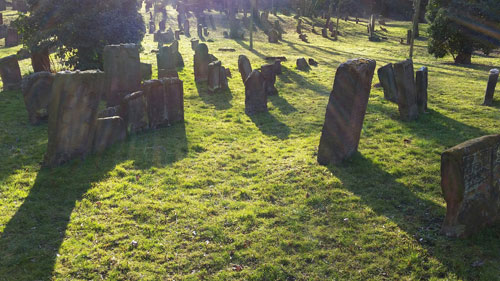
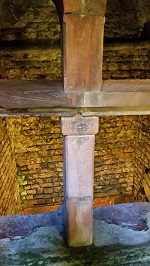
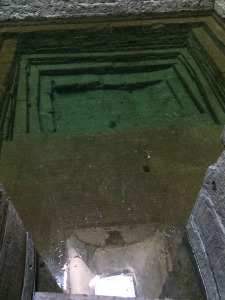
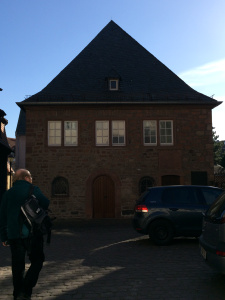
Heiliger Sand in Worms Mikveh/Speyer Entrance to Mikveh Old Synagogue/Worms
On Tuesday and Wednesday, we were in Mainz, where we took in the new Synagogue and visited the Chagall Windows at St. Stephens Church. We also went to Speyer to view the ShPIRA Museum, the remains of the Old Synagogue (1185, and still in use today), and its incredible Mikveh (Ritual Bath), the oldest one of its kind north of the Alps (1120). The Synagogue was destroyed by the Nazis during Kristallnacht in 1938, but the stones from the Synagogue covered up the entrance to the Mikveh so thoroughly that it went unharmed for the remainder of the War. In Worms, the great Bible scholar/commentator Rabbi Schlomo Yitzchaki (Rashi) lived and taught during the Middle Ages, roughly 1060-1105. The Rashi house provided many insights into jewish learning in the High Middle Ages.
Day 8: Bacharach: Legend and Living History
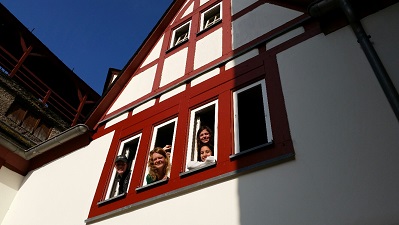
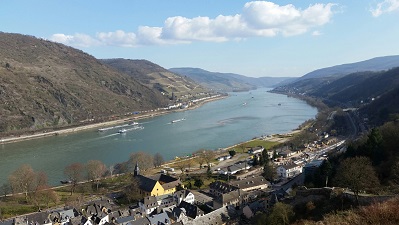
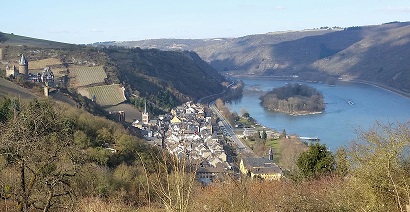
Bacherach am Rhein was our next stop, where we stayed in the castle Burg Stahleck high above the river, which has been converted into a Youth Hostel. The students had read Heine’s famous Novella, The Rabbi of Bacharach, and the Sankt Werner Kapelle, which 20 years ago was on the verge of collapse, was on the trail up to the Castle. Sankt Werner is named thus as the supposed sanctified victim of a Blood Libel, a so-called Ritual Murder, one of the chief myths that circulated from the Medieval into the Early Modern Period and beyond of Jews murdering a Christian child for the use of their blood. The Catholic Church of the region wanted to allow the Saint Werner Chapel to collapse, and thus all memory of the sanctification and its ongoing effect erased, but a grassroots organization led by local Lawyer Peter Keber, whom Professor Leventhal met while on the mountain path going back to the Castle, raised 6m EURO to have the Chapel transformed into a site of Christian-Jewish Reconciliation work, a series of ongoing lectures, workshops and talks on German-Jewish Relations. Peter came by Friday morning to drop off the volume Toleranz vor Augen (Tolerance before Our Very Eyes) [Mainz, 2010], which contains documentation of the project and Das Forum 2008-2009.
Day 9: Cologne
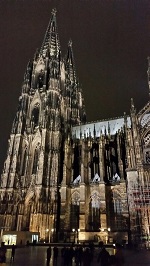 |
Cologne was our last stop before heading back to Frankfurt and then home. Unfortunately, the entire archeological zone is now closed due to the construction of the New Jewish Museum and Jewish Center. However, we visited the Olympics Museum to look for traces of the 1972 Munich Olympics, in which eleven Israeli athletes were killed in a shootout after they were held hostage and then abducted by members of Black September. To our amazement, we found only one small “black box” and a small plaque commemorating the massacre. The next morning, we went to the Stadtmuseum (The City Museum), where detailed histories of the Jews of Cologne provided us with an in-depth sense of Jews’ lives from the Middle Ages until the Nazi Genocide. In 1941, all avenues to escape the Nazi reign of terror were shut down, and by late 1942, most of the city’s 11,000 Jews had been deported to the concentration camps and killing centers in the East. The anti-Semitic figure of the Judensau (a mockery of Judaism and Jewish Dietary law) is found on a seat in the Cologne cathedral dating from 1210; the first pogrom against the Jews had occurred in 1348-49; and the Jews were expelled from the city in 1478, only allowed to return in the late 18th century. This was an amazing trip. We all saw and learned so much. To experience these memorials, museums, and sites of remembrance/commemoration first hand enabled us to get a fuller, richer, more textured sense of Jewish History in Germany, the relations between Germans/Christians and Jews, and the ties that connected them since the Early Middle Ages. Most interesting for the group was to be able to question the well-rehearsed figures of the Ghetto Jew and Hofjude, to learn about Landjuden, and to place alongside the history of oppression and victimhood (to be sure, a very important vector of German-Jewish History) another history of periodic but significant co-existence, even flourishing. We experienced the pre-history of the Haskalah, the Jewish Enlightenment and the drive for emancipation in the second half of the 18th century. |
An earlier collaborative research project was conducted by Professor Rob Leventhal with five W&M undergraduates during the spring and summer of 2007. The group traveled to Munich for spring break March 9-17, 2007 thanks to grants from The Reves Center, the Charles Center, and the Associate Provost for Research, to interview members of the Jewish Community, experience Jewish sites of remembrance, and explore Munich's Jewish history.















